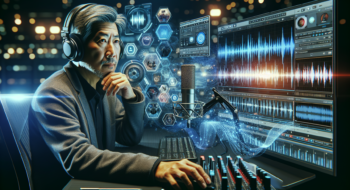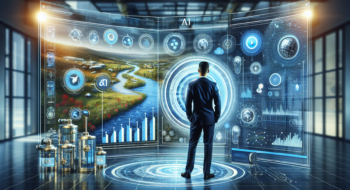The AI Revolution in UX Design
In the digital universe, where trends flicker and vanish faster than a smartphone screen can refresh, Artificial Intelligence (AI) has emerged as a beacon of transformation in user experience (UX) design. We’re not just talking minor tweaks and sips of improvement here; we’re diving headfirst into a full-blown overhaul that elevates usability to dizzying heights. Let’s peel back the layers and explore howAI Revolution is shaking things up in the UX world, making it ultra-personalized, remarkably efficient, and irresistibly user-friendly.
The Power of Personalization
Picture this: you walk into a store, and the salesperson greets you by name, knows your preferences, and even suggests products based on your past purchases. That’s the magic of personalization, and AI is the wizard behind the curtain. By sifting through endless piles of data—like users’ behavior, preferences, and previous interactions—AI algorithms craft experiences that feel tailor-made for every individual.
Real-World Examples
- Predictive UX: Think about tools like Predictive UX, which use smart algorithms to decode patterns in user data. This means eCommerce apps can not only anticipate when you need to restock that favorite item but also nudge you right when it’s time to hit that reorder button. It’s like having a shopping assistant seamlessly guiding you through your needs.
- Chatbots: Ever interacted with a chatbot and felt like you were talking to a real human? That’s the brilliance of AI-powered chatbots, like those from HubSpot. They’re not just here to respond; they’re on a mission to understand your needs, providing you with instant support and turning mundane inquiries into engaging conversations through slick Natural Language Processing (NLP) algorithms.
Intelligent Automation
Let’s face it: no one enjoys the drudgery of repetitive tasks. Enter AI, our stalwart ally that takes charge of the mundane and liberates designers to unleash their creative genius. How does it do that? Let’s delve into some exhilarating ways AI is streamlining the design process.
Automated Design Audits
Forget old-school assessments. Tools like UXaudit.io and Visualeyes have turned the game upside down. They dive deep into user behaviors, pinpointing usability issues faster than you could call a meeting. UXaudit.io dishes out a nifty UX score along with insights into engagement, task completion, and pesky error rates, while Visualeyes employs eye tracking technology to craft stunning heatmaps and scroll maps—because seeing is believing!
Design Prototyping and Testing
Now, hold on to your hats! AI tools—such as Uizard, Fronty, and Mockitt AI—are strutting their stuff by transforming scribbles into functional prototypes in record time. Imagine generating HTML and CSS code from mere images or predicting user navigation with surgical precision, shaping prototypes that mirror real-world behavior. It’s like the magic of carpentry, but for the digital world.
Predictive Analytics
Is it a crystal ball? No, it’s just AI flexing its muscles in predictive analytics. By mining user data and employing machine learning algorithms, AI churns out insights that shine a light on user behavior, giving design decisions a serious boost.
User Behavior Analysis
In mobile app development, for instance, AI doesn’t just stop at surface analysis; it connects the dots in interaction patterns. It can predict how users will navigate through an app, allowing developers to position design elements that make finding their way feel as effortless as breathing. Talk about a user-centric approach!
Enhancing Accessibility
AI isn’t just a whiz at making things efficient; it’s also a champion for inclusivity, making digital interfaces accessible to everyone, including those with disabilities. Here’s how:
Accessibility Insights
Tools like Microsoft’s Accessibility Insights and UserWay lead the charge, ensuring designs measure up to vital accessibility standards like WCAG 2.1 AA. They offer AI-driven insights to spot and remedy accessibility hiccups long before they become persistent issues.
Assistive Technologies
AI-powered assistive technologies, including voice recognition and screen readers, enable users to navigate apps using their voice or convert text to speech, opening up digital landscapes to individuals with visual or motor impairments. It’s about making tech work for *everyone*.
Voice User Interface (VUI)
Stepping into the limelight is the voice user interface, or VUI. With the rise of voice assistants like Siri, Alexa, and Google Assistant, designers are rethinking how users interact with their applications. AI-powered VUIs offer a hands-free experience that’s not just intuitive; it’s downright revolutionary.
Design Considerations
Designers must put their thinking caps on when embracing VUI. It’s all about understanding user interaction with voice commands and designing interfaces that react smoothly to a variety of requests. No pressure, right?
Customizing the User Journey
With AI on board, user journeys are not just linear pathways; they’re intricate webs of interactions. Dynamic personalization tools such as Pendo AI, Algolia, and Dynamic Yield tailor onboarding experiences, support, and content in real-time, based on each user’s unique fingerprint. It’s like having a personal concierge for every user that makes their journey smoother and oh-so-engaging.
Reducing Bias in UX Design
AI isn’t just about bells and whistles; it can help wipe out bias in UX design. Yes, we’re talking about fairness and inclusivity. How? Through rigorous bias detection.
Bias Detection
Enter tools like Google Fairness Indicator and MonkeyLearn, which sniff out pesky biases hidden in user experiences. Whether it’s skewed algorithms or stereotypes in design, these warriors surface biases and suggest alternatives that pave the way for more inclusive content.
Balancing Automation and Human Touch
Now, let’s hit pause for a moment. As fabulous as AI is, we can’t forget about the human element. It’s crucial to find that sweet spot between automation and the human touch. Why? Because the heart of good design lies in its relatability.
Human-Centric Design
AI should be embraced as a tool that enhances human interaction rather than replacing it. Designers need to carefully consider where AI fits within their strategy to ensure the experience remains meaningful and, above all, centered around the user.
Ethical Considerations
It’s not all rainbows and butterflies; diving into AI integration in UX design brings ethical questions to the forefront. Designers must juggle the responsibilities that come with data.
Data Privacy and Transparency
It’s a hard truth: AI algorithms must uphold transparency and fairness to avoid backlash. This means prioritizing data privacy for users and being clear about how their information is utilized. Navigating these waters is essential for establishing trust.
Conclusion
The influence of AI on UX design is a profound revelation that simply cannot be ignored. Leveraging data, automation, and machine learning has the potential to elevate user experience design into a realm of unprecedented personalization, efficiency, and engagement. But hold on; we must tread carefully as we navigate ethical considerations, maintain a balance between automation and a human touch, and stay on the pulse of AI innovations. The realm of UX design is poised for a thrilling ride with AI on board.
So, are you ready to step into this brave new world? Incorporating AI into your UX design process can lead to heightened user engagement, improved productivity, and data-informed decision-making. As AI continues to advance, the horizon is set for exciting developments that will forever transform our approach to UX design.
Want to stay updated on the latest news about neural networks and automation? Check out our other popular articles!







